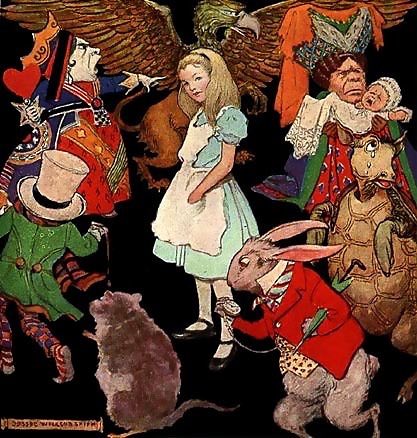Main Content
Lesson 2: Retail Strategic Planning
- First Page
- Previous Page
- 5
- 6
- 7
- Next Page
- Last Page
Concluding Remarks
In this lesson and the associated textbook chapter, we discussed the retail strategic planning process and its importance for retailers in today’s competitive marketplace. Retail strategy was described as an overall plan that guides a retailer's decisions, developed through the strategic retail planning process. The steps of this process are discussed in depth in your textbook chapter.
 Retailers must set goals and objectives that are derived from their mission statement. Goals and objectives give the retailer direction on where it's headed and what will be needed to get there. Have you ever read Lewis Carroll's Alice's Adventures in Wonderland? There is a wonderful dialogue between Alice and the Cat that speaks to the need for goals, whether in our personal lives or in business:
Retailers must set goals and objectives that are derived from their mission statement. Goals and objectives give the retailer direction on where it's headed and what will be needed to get there. Have you ever read Lewis Carroll's Alice's Adventures in Wonderland? There is a wonderful dialogue between Alice and the Cat that speaks to the need for goals, whether in our personal lives or in business:
"Would you tell me please, which way I ought to go from here," asked Alice.
"That depends a good deal on where you want to get to," said the Cat.
"I don’t much care where—" said Alice.
"Then it doesn’t matter which way you go," said the Cat. (Carroll, 1920, p. 89)
Goals and objectives set the course for our planning.
Retailing objectives may focus on market performance (obtaining a specific level of sales and/or market share), financial objectives (return on investments or profit), societal objectives (supporting local communities or the environment), and personal objectives (enjoyment or feelings of achievement). Financial objectives are paramount, because if the retailer isn't making money, the organization will go bankrupt. However, other objectives are important as well, acting as guiding forces for day-to-day activities.
This lesson also provided a discussion on corporate social responsibility and how retailers are facing the racial inequality and injustice felt by many people in our communities. Next, strategic windows of opportunities were discussed.These opportunities or holes in the marketplace often fit the firm's capabilities and are being overlooked by competitors. These opportunities, along with threats or problems that exist in the environment, become apparent to retailers when they conduct a SWOT analysis. A complete description of how to conduct a SWOT analysis appears in the textbook chapter.
Finally, you learned about four types of growth opportunities for retailers. Successful retailers are committed to growth; those that end up in the black hole of bankruptcy are not. As marketing consultant Jeff Sauer (2014) says, "If your company is not growing, then something is dying. The business owners lose profit, employees, their own equity, or they lose a combination of all three" (para. 22).
References
Carroll, L. (2010). Alice's adventures in Wonderland. London, United Kingdom: Macmillan & Co., Ltd.
Sauer, J. (2014). Career advice for advancement #4: If you're not growing, you're dying. Jeffalytics. Retrieved from http://www.jeffalytics.com/growing-business-advice/
![]()
- First Page
- Previous Page
- 5
- 6
- 7
- Next Page
- Last Page
